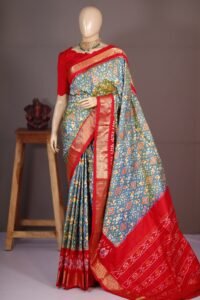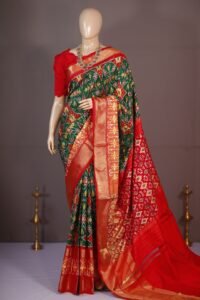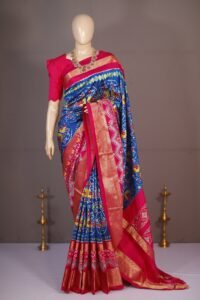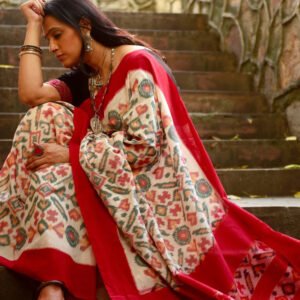Hyderabad Patola sarees, woven in the famous weaving hub of Pochampally, are celebrated for their timeless elegance and intricate Ikat patterns. Known as a fusion of tradition and artistry, these sarees stand apart for their vibrant colors, detailed motifs, and unique weaving methods. Each saree reflects not just fashion but the skill, patience, and heritage of master weavers.




How long does it take to weave a Hyderabad Patola saree?
Hyderabad Ikat Patola sarees are known for their intricate tie-and-dye weaving technique. In single Ikat Patola sarees, either the warp or weft is dyed before weaving, which takes around 7 days to complete a saree. Double Ikat Patola sarees involve dyeing both warp and weft yarns multiple times, aligning them with precision on the loom. While weaving, both yarn and weft yarn should align correctly, which requires precision, skill, and time. This process can takes 1–3 months to weave a saree, as even a small misalignment affects the clarity of the design.
So, in short, weaving a Hyderabad patola saree takes 7 days to 2 months of time, depending on the design and weaving process.
How to Check the Quality of Hyderabad Patola Saree?
Here are some simple ways to check the Quality of Hyderabad Patola Saree.
- Clarity of Design Edges – High-quality Patola sarees have sharp, well-defined motifs. If the edges look blurred or hazy, the saree is of lower precision.
- Brightness and Contrast of Colors – Authentic sarees display rich, vibrant colors that stand out due to repeated tie-and-dye work. Dull shades indicate poor dyeing or lower quality.
- Blurriness Direction – Check whether the blur appears in one direction or both:
- Single Ikat → blur only in one direction (more affordable).
- Double Ikat → blur in both warp and weft, requiring high precision and months of work (more valuable).
- Type of Silk Yarn – Ask if the saree is woven with 8-cord silk. This ensures premium shine, durability, and higher pricing.
- Borders Used – Plain borders cost less, while zari or Ikat-patterned borders enhance both beauty and price.
- Designs and Motifs – Smaller, intricate motifs demand more time and skill from weavers, making the saree costlier. Larger or simpler motifs are less time-consuming.
Different Types of Patola Sarees: What Are the Options?
Patola sarees are admired for their unique Ikat weaving techniques and vibrant motifs. They can be classified based on designs, place of origin, and weaving type.
Types by Design
- Narikunj Patola – Made using the double Ikat technique, featuring rhombus or square designs often embossed with animal or bird motifs.
- Navratan Patola – Inspired by the “Navratan” (nine precious gemstones), these sarees display floral and geometric arrangements symbolizing prosperity.
- Chhabdi Patola – Characterized by small motifs arranged like a basket (Chhabdi), often combined with floral and bird patterns.
- Rattan Chowk Bhat – Known for symmetrical geometric layouts.
- Fulwali Bhat Design – Features delicate floral patterns, adding elegance and grace.
Types by Place
- Hyderabad Patola – Woven in Pochampally village near Hyderabad, often with zari borders and distinctive Ikat patterns.
- Patan Patola (Gujarat) – The most prestigious, made in Patan, famous for precise double Ikat weaving.
- Rajkot Patola – Originating from Rajkot, with simpler motifs compared to Patan Patola.
- Gujarati Patola – Broader term for Patola sarees made in Gujarat, renowned for rich heritage.
Types by Weaving Technique
- Single Ikat – Either warp or weft yarn is tie-dyed before weaving. Common in Pochampally Patola sarees, these are more affordable.
- Double Ikat – Both warp and weft yarns undergo tie-and-dye, aligned with precision to create complex, bright, and sharp designs. Highly labor-intensive, taking months to complete, and priced at a premium.
Also read: 5 Popular Pochampally Sarees Shops in Hyderabad
Single vs. Double Ikat
The difference between single and double Ikat lies in the dyeing and weaving process. In Single Ikat, only the warp or weft yarn is tie-dyed before weaving, making it simpler, quicker, and more affordable. Designs may show slight blur in one direction. In Double Ikat, both warp and weft yarns are resist-dyed multiple times and then carefully aligned on the loom. This results in brighter, sharper motifs with high precision but requires months of labor. Double Ikat sarees are rare, more intricate, and highly valued, while single Ikat is more budget-friendly and widely available.
Best Shops To Get Authentic Hyderabad Patola Saree
- Shree Handlooms, LB Nagar, Hyderabad
- DSR Weaves PVT Market HYD.
- Roopanjali Silks PVT Market HYD.
Conclusion
Hyderabad Patola sarees are not just garments but symbols of India’s weaving legacy. Whether it is the simpler single Ikat or the luxurious double Ikat, each piece reflects a blend of tradition, precision, and artistry. Knowing how to check quality and the different types helps buyers make informed choices while appreciating the craft behind every thread.

Delivered in 3 days. Nice saree. Liked it